Daily Current Affairs for UPSC 25th Oct 2025



| Index |
| S.No | Topic | Page No |
| Daily Hindu Analysis (YouTube) |
| 1. | Respect the health rights of India’s children | |
| 2. | The mirage of port-led development in Great Nicobar | |
| 3. | Gyan Bharatam Mission to ink pact with institutes | |
| 4. | Japan’s new PM commits to higher defence spend, ties with India, Quad | |
| 5. | Activists seek Centre’s help to check leachate discharge into Aravalis | |
| 6. | India opposed to any move that may affect truce in Gaza | |
| Daily Current Affairs (App) |
| 7. | Iran Ratifies CFT Treaty in Bid to Ease Economic Isolation | |
| 8. | OpenAI launches ChatGPT Atlas Web Browser | |
| 9. | National Means-cum-Merit Scholarship Scheme (NMMSS) | |
| 10. | NPCI launches “UPI Help” AI Assistant | |
Respect the health rights of India’s children
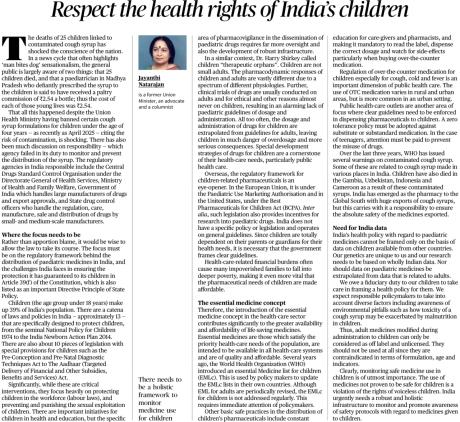
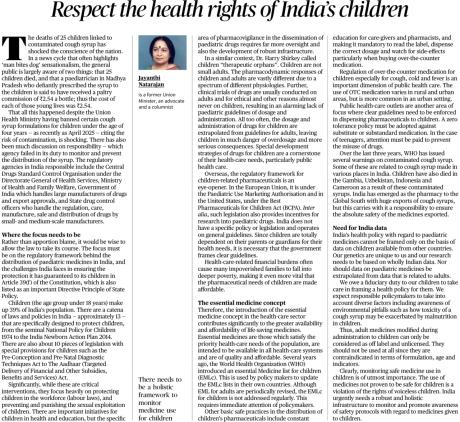
Syllabus Mapping:
- GS Paper 2: Issues relating to development and management of health, governance, government policies and interventions, health rights of vulnerable sections.
Context: The tragic deaths of 25 children due to contaminated cough syrup have once again exposed the loopholes in
India’s drug regulatory system and the neglect of child-specific health rights. Despite existing bans on certain paediatric cough syrups, enforcement failures and lack of pharmacovigilance continue to threaten child health safety in India.
Regulatory Failures and Gaps
- The incident occurred even though the Union Health Ministry had banned certain cough syrup formulations for children under five, as early as April 2025, due to toxicity risks.
- Agencies responsible—Central Drugs Standard Control Organisation (CDSCO), Directorate General of Health Services, and State Drug Control Officers—failed to monitor and prevent the sale of such drugs.
- This calls for a stronger regulatory mechanism to oversee the manufacture, sale, and distribution of paediatric medicines, especially by small and medium pharmaceutical firms.
Where the Focus Needs to Be
- Instead of assigning blame, emphasis should be placed on reforming the regulatory framework for paediatric medicines.
- India has numerous policies—like the National Policy for Children (1974) and the National Action Plan for Children (2014)—but implementation remains weak.
- Protecting children’s rights under Article 39(f) of the Constitution is a Directive Principle of State Policy, mandating the State to ensure children grow in safe conditions.
Pharmacological Challenges - Children are not small adults — their physiological and metabolic responses differ widely.
- Most clinical trials are conducted on adults; paediatric dosages are extrapolated, leading to under- or over-dosing and severe side effects.
- There is an urgent need for paediatric-specific drug development guidelines and better pharmacovigilance infrastructure.
International Practices - The European Union’s Paediatric Use Marketing Authorisation (PUMA) and U.S. Best Pharmaceuticals for Children Act (BPCA) provide incentives for paediatric drug research.
- India lacks similar legislation, leaving children dependent on adult formulations.
- With several child deaths linked to exported contaminated syrups, India must also ensure stringent international compliance to protect its global reputation.
Need for Affordable and Safe Medicines - Healthcare costs force many families into poverty, making essential medicine access vital.
- The Essential Medicines List (EML)—recommended by the WHO—should be updated regularly to include child-specific formulations.
- India should create a holistic framework to ensure paediatric medicines meet safety, affordability, and availability standards.
Way Forward - Establish a robust pharmacovigilance system dedicated to paediatric drugs.
- Strengthen oversight of manufacturing units and ensure real-time monitoring of production.
- Implement mandatory clinical trials for children’s formulations under ethical supervision.
- Promote education for pharmacists and caregivers on correct dosage, labelling, and side effects.
- Hold policymakers and regulators accountable for negligence in enforcing child safety norms.
UPSC Mains: Q. “Ensuring the health rights of children in India requires not just welfare policies but a robust framework for paediatric drug regulation.” Discuss.
The mirage of port-led development in Great Nicobar
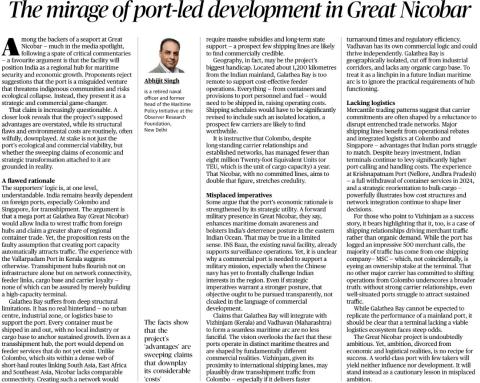
Syllabus Mapping: - GS Paper 3: Infrastructure – Ports, Shipping, and Inland Waterways; Conservation, Environmental Impact Assessment; Sustainable Development and Economic Growth.
Context: The proposed transshipment port at
Galathea Bay in Great Nicobar is being touted as a major strategic and economic project that could make India a regional maritime hub. However, a critical analysis reveals significant flaws in the rationale, environmental costs, and commercial viability, suggesting that the project may be more of a mirage than a game-changer.
A Flawed Rationale
- Proponents argue that the port will help India capture traffic from foreign ports like Colombo and Singapore, which currently dominate transshipment.
- The logic assumes that creating port capacity automatically attracts traffic, an assumption refuted by the experience of Vallarpadam Port in Kerala.
- Transshipment success depends not only on capacity but also on connectivity, feeder links, cargo base, and logistics ecosystems—all of which Galathea Bay lacks.
Structural Limitations: - Great Nicobar has no real hinterland—no industrial or economic zones that could sustain the port.
- All cargo and personnel would need to be shipped in from the mainland, raising operational costs.
- The remote location, 1,200 km from the Indian mainland, makes cost-effective operations difficult and long-term economic sustainability questionable.
Misplaced Strategic Imperatives - Advocates justify the port by citing India’s strategic presence in the eastern Indian Ocean and the need to counter China’s influence.
- India already has INS Baaz, a naval air station at Great Nicobar that provides surveillance coverage.
- The argument that the port enhances maritime deterrence lacks transparency and evidence of long-term strategic necessity.
Comparative Perspective: - Colombo Port handles over eight million TEUs annually, while Nicobar’s target of one million TEUs appears unrealistic given its isolation.
- Existing ports like Vizhinjam (Kerala) and Vadhavan (Maharashtra) are already better positioned and face fewer ecological challenges.
Economic and Environmental Constraints - The ecological cost of building the port is significant. Large-scale deforestation, soil erosion, and habitat loss threaten Nicobar’s fragile ecosystem.
- The Andaman and Nicobar Islands are part of a sensitive seismic zone, making massive infrastructure projects risky.
- Proposals often downplay the socio-ecological consequences and the displacement of indigenous communities.
Lacking Logistics and Commercial Viability - Major global transshipment hubs like Singapore and Colombo succeed due to integrated logistics, rebates, and maritime relationships, which India currently lacks.
- Even high-performing Indian ports like Krishnapatnam and Vizhinjam illustrate that sustained success depends on network integration and liner connectivity, not isolated port expansion.
- Galathea Bay, being geographically remote and logistically isolated, faces a high risk of becoming commercially nonviable.
UPSC Mains: Q. “Port-led development in ecologically sensitive zones such as Great Nicobar may promise strategic gains but raises serious questions of sustainability and economic prudence.” Examine.
Gyan Bharatam Mission to ink pact with institutes GS Paper 1: Indian Culture – Salient aspects of Art Forms, Literature, and Architecture from ancient to modern times.
Context: The Gyan Bharatam Mission, a flagship initiative of the Union Ministry of Culture, is set to sign MoUs with around 20 institutions across India for the conservation, digitisation, and promotion of ancient manuscripts. Over the coming weeks, 30 more institutes will join this effort.
About the Mission:
- Objective: To identify, digitise, conserve, and disseminate India’s vast manuscript heritage through a unified digital platform.
- Platform: Establishes the National Digital Repository (NDR) to share India’s manuscript legacy globally.
- Structure:
- Institutions are categorised as Cluster Centres and Independent Centres.
- Each cluster centre will execute activities related to manuscript preservation and guide partner institutions.
- Activities include:
- Survey and cataloguing of manuscripts.
- Conservation, translation, and digital archiving.
- Capacity building and research.
Funding Framework: - Funding to be released in phased instalments (70% initially, 30% after progress verification).
- The mission ensures accountability through periodic reports and audits.
Significance: - Preserves India’s knowledge heritage spanning ancient literature, science, art, and philosophy.
- Strengthens digital cultural diplomacy by sharing India’s intellectual legacy worldwide.
UPSC Prelims: Q. Which of the following statements about the
Gyan Bharatam Mission is/are correct? 1. It is implemented by the Ministry of Education to digitise ancient Indian manuscripts. 2. It aims to establish a National Digital Repository to share India’s manuscript heritage. 3. The mission categorises institutions as cluster centres and independent centres. Options:
(a) 1 only
(b) 2 and 3 only
(c) 1 and 3 only
(d) 1, 2 and 3
Answer: (b) 2 and 3 only
Japan’s new PM commits to higher defence spend, ties with India, Quad
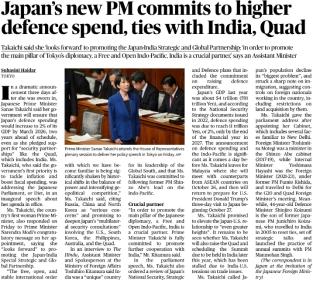
GS Paper 2: International Relations India and its neighbourhood; bilateral, regional and global groupings; effect of policies of developed countries on India’s interests.
Context:
Japan’s new Prime Minister Sanae Takaichi has announced an ambitious policy agenda focusing on enhancing defence spending and strengthening strategic partnerships, particularly with India and the Quad (U.S., Australia, and Japan).
Key Highlights:
1. Defence Spending Commitment: Japan will increase its defence expenditure to 2% of its GDP by March 2026, two years ahead of schedule. o This move aligns with Japan’s 2022 National Security Strategy, aiming to counter regional threats from China, Russia, and North Korea.
2. Strengthening Indo-Pacific Partnerships: PM Takaichi reiterated Japan’s commitment to a Free and Open Indo-Pacific (FOIP) — a key diplomatic framework initiated under former PM Shinzo Abe. o She emphasised that India is a crucial partner in this vision and pledged deeper cooperation under the Japan-India Strategic and Global Partnership.
3. Domestic Priorities: Takaichi also prioritised tackling inflation, boosting fiscal spending, and addressing Japan’s population decline, which she termed as a “biggest problem.” o Her stance on immigration remains conservative, continuing restrictions on foreign labour inflows. 4. Foreign Policy Outlook: o Japan plans to strengthen multilateral security consultations with the U.S., South Korea, Australia, and ASEAN countries. o She is expected to attend upcoming ASEAN and U.S.-Japan meetings, reflecting Japan’s active global diplomacy.
Significance:
- Marks Japan’s continued evolution from its post-war pacifist stance towards a proactive defence posture.
- Reinforces India’s position as a key strategic partner in maintaining regional stability in the Indo-Pacific amid China’s assertiveness.
UPSC Prelims: Q. The “Free and Open Indo-Pacific” (FOIP) strategy, recently in news, is associated with which of the following countries?
(a) India
(b) Japan
(c) United States
(d) Australia
Answer: (b) Japan
Activists seek Centre’s help to check leachate discharge into Aravalis 
GS Paper 3 – Environment & Ecology: Environmental pollution, solid waste management, and conservation of ecosystems.
Contex
Environmentalists, wildlife activists, and residents in Gurugram have urged the Union Environment Ministry to intervene against the illegal discharge of toxic leachate from the Bandhwari landfill site into the Aravali forest region. The leachate, a hazardous liquid formed by decomposing waste, is contaminating forest areas and water bodies, posing risks to public health, wildlife, and groundwater.
Key Points:
1. Environmental and Health Hazard: The Bandhwari landfill, located on the Gurugram-Faridabad road, is reportedly releasing untreated leachate into nearby forest areas and Bandhwari village outskirts. o The leachate contains highly toxic substances harmful to both humans and wildlife in the Aravali ecosystem.
2. Repeated Complaints Ignored: o Activists, led by Vaishali Rana, have made multiple complaints to authorities, including the Municipal Corporation of Gurugram (MCG), Chief Wildlife Warden, and the Haryana Human Rights Commission (HHRC). Despite National Green Tribunal (NGT) orders, there has been no significant improvement in managing the landfill.
3. Government Inaction: o The MCG had claimed to construct a “garland drain” to prevent leachate flow, but activists allege that no such structure exists. o The HHRC has sought a report from the Chief Secretary after confirming that the issue persists due to delay in managing legacy waste.
Environmental Significance:
- The Aravalis serve as a critical ecological barrier, preventing desertification and recharging groundwater.
- Continuous contamination could irreversibly damage local biodiversity, forest soil health, and water quality.
UPSC Prelims: Q. The term
“leachate” often seen in environmental reports refers to:
(a) A by-product of wastewater treatment
(b) A toxic liquid formed when water percolates through solid waste in landfills
(c) A chemical used to neutralize acidic soil
(d) A solution used in bioremediation
Answer: (b)
India opposed to any move that may affect truce in Gaza 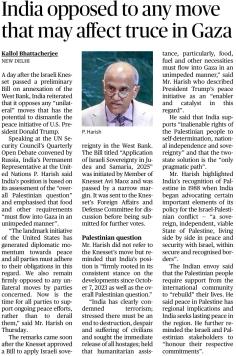
GS Paper: 2 – International Relations: India and its Neighbourhood, Bilateral, Regional and Global Groupings
Context: India reiterated its opposition to any unilateral moves that could undermine peace efforts between Israel and Palestine, following Israel’s Knesset passing a preliminary Bill on annexing parts of the West Bank.
Key Highlights:
- India’s Stand:
- India’s Permanent Representative to the UN, P. Harish, stated that India’s position is based on the “overall Palestinian question”, emphasizing that essential supplies like food and fuel must flow into Gaza unhindered.
- India opposed any move that could derail the ongoing peace process and urged all sides to adhere to their international obligations.
- Support for Two-State Solution:
- India reaffirmed support for the “two-state solution” — the creation of a sovereign, independent, and viable State of Palestine, living peacefully with Israel within secure and recognized borders.
- Humanitarian Emphasis:
- India called for an end to terrorism, the protection of civilians, and the release of hostages, while stressing the need for humanitarian assistance to Gaza.
- Historical Context:
- India recognized Palestine in 1988 and has since advocated for peaceful coexistence and the resolution of the conflict through dialogue.
India’s Diplomatic Approach: - Balances its historic support for the Palestinian cause with its strategic ties to Israel.
- Emphasizes peace, stability, and adherence to international law in West Asia.
- Advocates a multilateral solution involving the UN and major powers to sustain ceasefire and rebuild Gaza.
UPSC Prelims: Q. India’s long-standing position on the Israel-Palestine conflict is based on which of the following principles? 1. Support for the two-state solution 2. Recognition of Palestine’s sovereignty 3. Advocacy for Israel’s complete withdrawal from all occupied territories Select the correct answer using the code given below:
(a) 1 and 2 only
(b) 2 and 3 only
(c) 1 and 3 only
(d) 1, 2 and 3
Answer: (a) 1 and 2 only
Iran Ratifies CFT Treaty in Bid to Ease Economic Isolation
Syllabus:
GS Paper II — International Relations
Topic: Global Governance, Counter-terror Financing, and Foreign Policy
Context:
Iran’s government has ratified the
International Convention for the Suppression of the Financing of Terrorism (CFT) as part of efforts to meet
FATF requirements and reduce international financial isolation. The move is intended to restore credibility and improve access to the global banking system.
Key Points:
- What the CFT is: A UN treaty (1999) that criminalises the financing of terrorism and entered into force in 2002.
- Primary obligation: States must criminalise terrorist financing in national law aligned with the Convention.
- International cooperation: Parties commit to provide the greatest measure of assistance in investigations and proceedings.
- Mutual legal assistance: The treaty limits refusals based on bank secrecy for terrorism-financing probes.
- Evidence sharing: States must assist each other in gathering and exchanging evidence for criminal, civil, or administrative cases.
- Freezing and confiscation: The convention requires measures to freeze, seize or confiscate terrorist assets.
- FATF linkage: Ratification helps address FATF deficiencies, a step toward possible delisting from high-risk lists.
- Economic motive: The decision aims to improve Iran’s access to international finance and reduce sanctions-related isolation.
- Implementation challenge: Ratification alone is insufficient — effective enforcement and transparency are required for international trust.
- Geopolitical caveat: Progress will also depend on broader diplomatic and sanction dynamics with Western countries.
Source: Indian Express (IE)
OpenAI launches ChatGPT Atlas Web Browser
Syllabus:
GS Paper III — Science & Technology (AI, Digital Innovation)
Context:
OpenAI has launched
ChatGPT Atlas, an AI-integrated web browser aimed at transforming internet usage into a more conversational and automated experience. It is positioned as a key competitor to traditional browsers like Google Chrome.
Key Points
- What it is: A full-service browser with ChatGPT embedded directly into webpages for seamless assistance.
- Availability: Globally for macOS (Free, Plus, Pro, Go users); Business users in beta; Windows, iOS & Android versions coming soon.
- Built-In Memory: Remembers context, past research & preferences to personalize browsing; users retain full control to delete/manage memory.
- Agent Mode: Automates tasks—research, planning, scheduling—representing OpenAI’s shift toward hands-free browsing; in preview for Plus/Pro/Business users.
- User Benefits: Enhances efficiency by allowing AI support without switching tabs or copying content.
Source: Indian Express
National Means-cum-Merit Scholarship Scheme (NMMSS)
Syllabus: GS Paper II – Government Policies & Interventions
Topic: Education & Welfare Schemes for Vulnerable Sections
Context:
State Councils of Educational Research and Training (SCERTs) have released
application forms for NMMSS for various states, enabling eligible Class VIII students to apply for the scholarship.
Key Points – NMMSS: - Launch: 2008, as a Centrally Sponsored Scheme.
- Objective: Prevent dropouts after Class VIII and support meritorious students from economically weaker sections to pursue secondary education.
- Platform: Implemented via the National Scholarship Portal (NSP).
Benefits: - 1 lakh new scholarships every year (Classes IX–XII).
- Scholarship amount: ₹12,000 per year (₹1,000/month).
- Disbursed directly to students’ bank accounts via electronic transfer.
- State/UT-wise quota of scholarships.
Eligibility: - Family income ≤ ₹3.5 lakh/year.
- Minimum 55% in Class VII (relaxable by 5% for SC/ST).
- Must be studying in Govt./Govt.-aided/local body school.
- Not eligible: Students of KVS, NVS, and other residential schools.
- Reservations as per State norms.
Selection Process: - State/UT-level test for Class VIII students — Mental Ability & Scholastic Aptitude.
Scholarship Renewal Conditions: - Minimum 60% in Class X (5% relaxation for SC/ST).
- Must be promoted in first attempt from Class IX → X and Class XI → XII.
Source: NDTV
NPCI launches “UPI Help” AI Assistant
Syllabus:
GS Paper III — Economy (Digital Infrastructure & Financial Inclusion)
Context:
NPCI has introduced
“UPI Help”, an AI-based support system to strengthen grievance redressal and user assistance on the
Unified Payments Interface (UPI) platform. The initiative aims to improve transparency, efficiency, and user trust in digital payments.
Key Points
- Purpose: AI-powered assistant to resolve UPI transaction issues in real-time.
- Scope: Helps users with failed or pending payments, unclear transaction status, and error resolution.
- UDIR Integration: Built on the UPI Dispute Resolution system for quick grievance filing and tracking.
- Automation: Enables automated sharing of transaction details with issuing banks for faster settlement.
- Mandate Management: Offers a unified view of UPI Autopay mandates to manage recurring payments easily.
- User Benefit: Improves response time, transparency, and empowering users with payment insights.
- UPI Snapshot: UPI launched in 2016 by NPCI; handles 12+ billion monthly transactions (₹20 lakh crore+).
Source: Indian Express








